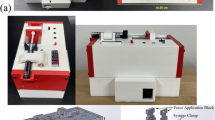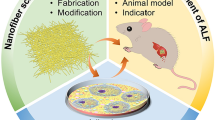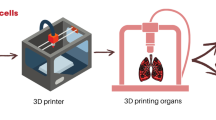Abstract
Although there have been significant advances in the development of fully functional vascular grafts suitable for coronary artery bypass graft surgery, so far no technology has been developed that meets all of the requirements suitable for clinical use. Here we present an approach using a decellularized biological membrane, seeded with smooth muscle cells (SMCs) and rolled into a tubular construct. We show that the human amniotic membrane provides a thin and strong biological extracellular matrix that supports the attachment and proliferation of both rat aortic SMCs and of human myofibroblasts. The results show that after 1 week in static culture, the rolled construct develops an elastic modulus higher than that of native tissue. The elastic modulus decreases with time in culture, suggesting that cells actively remodel the matrix. Cells continue to proliferate in the rolled state and histology images show that some cells attach to the neighboring membrane in the construct. The burst pressure of the construct remains below physiological levels. A bioreactor system was used to deliver flow to both the lumen and the ablumenal spaces through two separate flow circuits but resulting burst pressures of this treatment still remain below physiological values. Our study demonstrates that the human amniotic membrane is a cell biocompatible biological membrane that has the potential to be useful in a vascular application.









Similar content being viewed by others
References
Alford, P. W., et al. Vascular smooth muscle contractility depends on cell shape. Integr. Biol. 3(11):1063–1070, 2011.
Amensag, S., and P. S. McFetridge. Rolling the human amnion to engineer laminated vascular tissues. Tissue Eng Part C Methods 18(11):903–912, 2012.
Amiel, G. E., et al. Engineering of blood vessels from acellular collagen matrices coated with human endothelial cells. Tissue Eng. 12(8):2355–2365, 2006.
Arrigoni, C., et al. The effect of sodium ascorbate on the mechanical properties of hyaluronan-based vascular constructs. Biomaterials 27(4):623–630, 2006.
Beamish, J. A., et al. Molecular regulation of contractile smooth muscle cell phenotype: implications for vascular tissue engineering. Tissue Eng. Part B 16(5):467–491, 2010.
Bilodeau, K., et al. Design of a perfusion bioreactor specific to the regeneration of vascular tissues under mechanical stresses. Artif. Organs 29(11):906–912, 2005.
Campbell, G. R., and J. H. Campbell. Development of tissue engineered vascular grafts. Curr. Pharm. Biotechnol. 8(1):43–50, 2007.
Chlupac, J., E. Filova, and L. Bacakova. Blood vessel replacement: 50 years of development and tissue engineering paradigms in vascular surgery. Physiol. Res. 58(Suppl 2):S119–S139, 2009.
Crapo, P. M., T. W. Gilbert, and S. F. Badylak. An overview of tissue and whole organ decellularization processes. Biomaterials 32(12):3233–3243, 2011.
Dahan, N., et al. Porcine small diameter arterial extracellular matrix supports endothelium formation and media remodeling forming a promising vascular engineered biograft. Tissue Eng. Part A 18(3–4):411–422, 2012.
Forsey, R. W., and J. B. Chaudhuri. Validity of DNA analysis to determine cell numbers in tissue engineering scaffolds. Biotechnol. Lett. 31(6):819–823, 2009.
Gilbert, T. W., T. L. Sellaro, and S. F. Badylak. Decellularization of tissues and organs. Biomaterials 27(19):3675–3683, 2006.
Girton, T. S., et al. Mechanisms of stiffening and strengthening in media-equivalents fabricated using glycation. Trans. ASME 122:7, 2001.
Gui, L. Q., et al. Development of decellularized human umbilical arteries as small-diameter vascular grafts. Tissue Eng. Part A 15(9):2665–2676, 2009.
Hopkinson, A., et al. Amniotic membrane for ocular surface reconstruction: donor variations and the effect of handling on TGF-beta content. Invest. Ophthalmol. Vis. Sci. 47(10):4316–4322, 2006.
Isenberg, B. C., C. Williams, and R. T. Tranquillo. Small-diameter artificial arteries engineered in vitro. Circ. Res. 98(1):25–35, 2006.
Iwasaki, K., et al. Bioengineered three-layered robust and elastic artery using hemodynamically-equivalent pulsatile bioreactor. Circulation 118(14):S52–S57, 2008.
Konig, G., et al. Mechanical properties of completely autologous human tissue engineered blood vessels compared to human saphenous vein and mammary artery. Biomaterials 30(8):1542–1550, 2009.
Lee, P. H., et al. A prototype tissue engineered blood vessel using amniotic membrane as scaffold. Acta Biomater. 8(9):3342–3348, 2012.
L’Heureux, N., et al. A completely biological tissue-engineered human blood vessel. FASEB J. 12(1):47–56, 1998.
Liu, G. F., et al. Decellularized aorta of fetal pigs as a potential scaffold for small diameter tissue engineered vascular graft. Chin. Med. J. (Engl.) 121(15):1398–1406, 2008.
Luo, J. C., et al. A multi-step method for preparation of porcine small intestinal submucosa (SIS). Biomaterials 32(3):706–713, 2011.
Maharajan, V. S., et al. Amniotic membrane transplantation for ocular surface reconstruction: indications and outcomes. Clin. Exp. Ophthalmol. 35(2):140–147, 2007.
McFetridge, P. S., et al. Preparation of porcine carotid arteries for vascular tissue engineering applications. J. Biomed. Mater. Res. A 70(2):224–234, 2004.
Niklason, L. E., et al. Functional arteries grown in vitro. Science 284(5413):489–493, 1999.
Powell, D. W., et al. Myofibroblasts. I. Paracrine cells important in health and disease. Am. J. Physiol. 277(1 Pt 1):C1–C9, 1999.
Rayatpisheh, S., et al. Aligned 3D human aortic smooth muscle tissue via layer by layer technique inside microchannels with novel combination of collagen and oxidized alginate hydrogel. J. Biomed. Mater. Res. A 98(2):235–244, 2011.
Reing, J. E., et al. The effects of processing methods upon mechanical and biologic properties of porcine dermal extracellular matrix scaffolds. Biomaterials 31(33):8626–8633, 2010.
Rosenberg, N., et al. The modified bovine arterial graft. Arch. Surg. 111(3):222–226, 1976.
Seliktar, D., et al. Dynamic mechanical conditioning of collagen-gel blood vessel constructs induces remodeling in vitro. Ann. Biomed. Eng. 28(4):351–362, 2000.
Tosi, G. M., et al. Amniotic membrane transplantation in ocular surface disorders. J. Cell. Physiol. 202(3):849–851, 2005.
Vunjak-Novakovic, G., and R. I. Freshney. Culture of Cells for Tissue Engineering. Hoboken, NJ: Wiley-Liss, 2006, xiii, 512 pp.
Weinberg, C. B., and E. Bell. A blood vessel model constructed from collagen and cultured vascular cells. Science 231(4736):397–400, 1986.
Wilshaw, S. P., et al. Production of an acellular amniotic membrane matrix for use in tissue engineering. Tissue Eng. 12(8):2117–2129, 2006.
Acknowledgments
The authors would like to thank Dr. Eric Howard’s laboratory from the University of Oklahoma Health Sciences Center for kindly donating the SMCs as well as Normal Regional Hospital for providing the placentas to make our research possible. This work was funded by the American Heart Association.
Conflict of interest
Authors Brennan, Arrizabalaga, and Nollert declare that they have no conflict of interest.
Ethical Standards
All procedures followed were in accordance with the ethical standards of the responsible committee on human experimentation (institutional and national) and with the Helsinki Declaration of 1975, as revised in 2000 (5). Informed consent was obtained from all patients for being included in the study.
Animal Studies
No animal studies were carried out by the authors for this article.
Author information
Authors and Affiliations
Corresponding author
Additional information
Associate Editor Ajit P. Yoganathan oversaw the review of this article.
Rights and permissions
About this article
Cite this article
Brennan, J.A., Arrizabalaga, J.H. & Nollert, M.U. Development of a Small Diameter Vascular Graft Using the Human Amniotic Membrane. Cardiovasc Eng Tech 5, 96–109 (2014). https://doi.org/10.1007/s13239-013-0170-6
Received:
Accepted:
Published:
Issue Date:
DOI: https://doi.org/10.1007/s13239-013-0170-6




